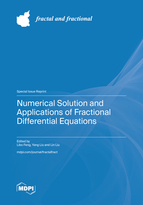Numerical Solution and Applications of Fractional Differential Equations
A special issue of Fractal and Fractional (ISSN 2504-3110). This special issue belongs to the section "Numerical and Computational Methods".
Deadline for manuscript submissions: closed (20 July 2023) | Viewed by 34706
Special Issue Editors
Interests: numerical methods and analysis of fractional PDE; application of fractional mathematical models
Special Issues, Collections and Topics in MDPI journals
Interests: finite element method; finite difference method; LDG methods; numerical methods for fractional PDEs
Special Issues, Collections and Topics in MDPI journals
Interests: viscoelastic fluid boundary layer flow; fractional anomalous diffusion; biological heat conduction
Special Issues, Collections and Topics in MDPI journals
Special Issue Information
Dear Colleagues,
In the last few decades, the application of fractional calculus to real-world problems has grown rapidly, with dynamical systems described by fractional differential equations (FDEs) representing one of the ways by which to understand complex materials and processes. Due to the power required to model the non-locality, memory, spatial heterogeneity and anomalous diffusion inherent in many real-world problems, FDEs have attracted significant attention in many fields of science and are still under development. However, generally, fractional mathematical models from science and engineering are so complex that analytical solutions are not available. Therefore, the numerical solution is an effective tool in fractional mathematical models.
This Special Issue aims to promote collaboration between researchers and practitioners in the application of fractional calculus, present the latest developments in fractional differential equations, report state-of-the-art and developing numerical methods and discuss future trends and challenges. We are inviting submissions of original research articles or comprehensive review papers. Topics of interest include, but are not limited to:
- Mathematical modelling of fractional dynamic systems;
- Analytical or semi-analytical solutions of fractional differential equations;
- Numerical methods to solve fractional differential equations, e.g., the finite difference method, the finite element method, the finite volume method, the spectral method, etc;
- Fast algorithm for the time- or space-fractional derivative;
- Mathematical analysis for fractional problems and numerical analysis for the numerical scheme;
- Applications of fractional calculus in physics, biology, chemistry, finance, signal and image processing, hydrology, non-Newtonian fluids, etc.
Dr. Libo Feng
Prof. Dr. Yang Liu
Dr. Lin Liu
Guest Editors
Manuscript Submission Information
Manuscripts should be submitted online at www.mdpi.com by registering and logging in to this website. Once you are registered, click here to go to the submission form. Manuscripts can be submitted until the deadline. All submissions that pass pre-check are peer-reviewed. Accepted papers will be published continuously in the journal (as soon as accepted) and will be listed together on the special issue website. Research articles, review articles as well as short communications are invited. For planned papers, a title and short abstract (about 100 words) can be sent to the Editorial Office for announcement on this website.
Submitted manuscripts should not have been published previously, nor be under consideration for publication elsewhere (except conference proceedings papers). All manuscripts are thoroughly refereed through a single-blind peer-review process. A guide for authors and other relevant information for submission of manuscripts is available on the Instructions for Authors page. Fractal and Fractional is an international peer-reviewed open access monthly journal published by MDPI.
Please visit the Instructions for Authors page before submitting a manuscript. The Article Processing Charge (APC) for publication in this open access journal is 2700 CHF (Swiss Francs). Submitted papers should be well formatted and use good English. Authors may use MDPI's English editing service prior to publication or during author revisions.
Keywords
- numerical methods
- mathematical modelling
- fractional calculus
- fractional differential equations
- numerical analysis
- fast algorithm








